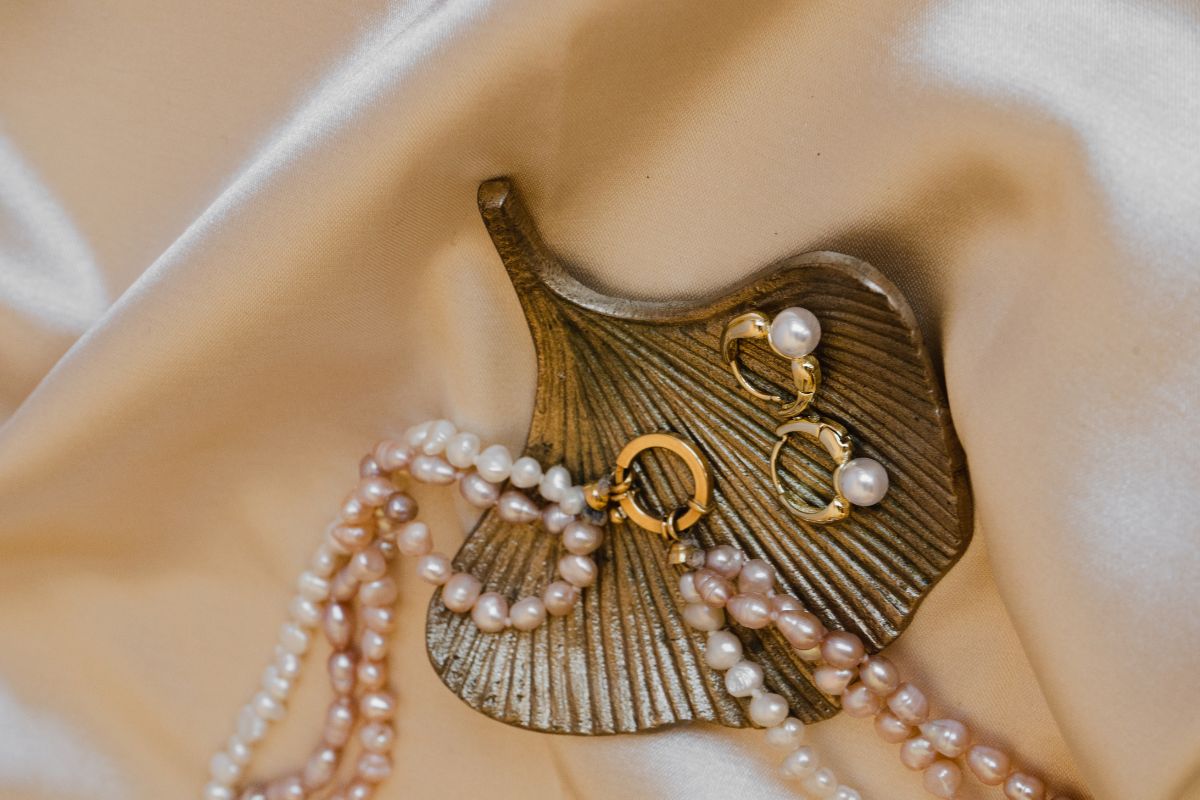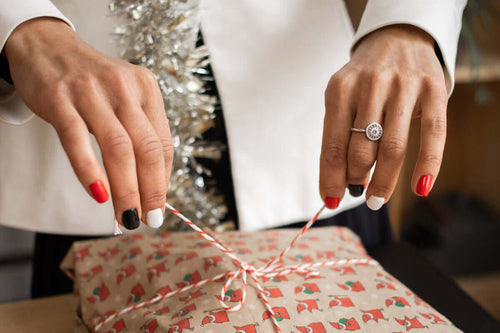Pearl necklaces have long been a symbol that resonates with notions of elegance and beauty. When you wear one, it's not just an accessory; it encapsulates a rich history of being a cherished gift, a fashion statement, and sometimes a family heirloom passed down through generations. The luster and simplicity of pearls on a string can amplify your attire, bringing forward an image of sophistication and grace that few other pieces of jewelry can match.
The giving of a pearl necklace often signifies a gesture of love and esteem, making it a perfect gift for special occasions like anniversaries or milestones. Beyond its aesthetic appeal, the choice of pearls can communicate a deep appreciation for the recipient's refined taste and the bond between giver and receiver. The pearls themselves carry an individual beauty, with each orb reflecting a unique journey from the depths of the ocean to becoming a part of your persona.
In different cultural contexts, the pearl necklace can adopt varied meanings. Whether seen as a marker of social status or imbued with spiritual and symbolic significance, it remains a versatile ornament. As a wearable piece, its adaptability means it fits seamlessly with both day-to-day wear and more formal, ceremonial outfits, ensuring that your pearl necklace is much more than a simple adornment; it's a subtle statement of your identity and values.
The Symbolism of Pearl Necklaces
Pearl necklaces carry deep symbolic meanings across cultures, signifying purity, wealth, love, and even spiritual wisdom. You will discover how these elegant pieces of jewelry serve as more than mere adornments.
Representations of Purity and Innocence
Pearls are known for their brilliant white luster, often associated with purity and innocence. In many cultures, you might find that a pearl necklace is chosen for bridal wear, symbolizing the wearer's pure heart as they step into a new chapter of life. This connection is deeply rooted in tradition and has made the pearl necklace a staple in weddings.
Connections to Wealth and Status
Throughout history, from ancient Rome to modern societies, pearl necklaces have been indicators of wealth and status. The rarity and luxury of pearls in the past made them accessible only to the affluent, thus wearing them signaled an elevated social standing. Even today, pearls remain a sign of refined taste and sophistication.
Associations with Love and Fertility
Pearls also carry connotations of love, fertility, and commitment, making them meaningful gifts between partners. The connection between pearls and fertility may stem from their oceanic origins, resembling seeds or eggs in their white, sometimes creamy appearance. This symbolism extends to represent the wearer's loyalty and the promise of a fruitful union.
Cultural and Historical Significance
The symbolic meanings of pearls are multifaceted, bearing great cultural and historical significance. In different eras and locales, such as in ancient India or the United States, pearls have been cherished and ascribed various interpretations, from tokens of admiration to emblems of power. The historical significance is fascinating, highlighting the pearl's journey through epochs and empires.
Pearls in Mythology and Spirituality
Pearls hold a special place in mythology and spirituality, often associated with the celestial and the divine. They have been believed to offer protection against negative energy and endowed with healing properties. In spiritual terms, pearls are seen as symbols of balance and harmony, a testament to their formation as a response to irritation within an oyster, turning adversity into a beautiful outcome.
Types of Pearls and Pearl Necklaces

In your exploration of pearl necklaces, it's essential to consider the variety of pearls available as well as the assortment of styles in which they can be arrayed. Whether you prefer the traditional elegance of a classic white strand or something more avant-garde, understanding the differences in types and styles is fundamental to making an informed choice.
| Pearl Type | Description | Pearl Necklace |
|---|---|---|
| Akoya Pearls | Classic white or cream-colored pearls with high luster; typically small to medium-sized. | Akoya Pearl Necklace |
| Tahitian Pearls | Naturally dark-colored pearls ranging from black to gray and peacock green; larger in size. | Tahitian Pearl Necklace |
| South Sea Pearls | Large and luxurious pearls with a natural white or golden color; harvested in the South Seas. | South Sea Pearl Necklace |
| Freshwater Pearls | Often irregular in shape, available in various colors including white, pink, and lavender; affordable option. | Freshwater Pearl Necklace |
| Abarognosia Pearls | Rare and highly prized pearls from the abalone shell; known for their vibrant and iridescent colors. | Abarognosia Pearl Necklace |
| Mabe Pearls | Also known as blister pearls; hemispherical in shape and often used in earrings or rings. | Mabe Pearl Necklace |
| Coin Pearls | Flat and disc-shaped pearls resembling coins; used in contemporary and unique necklace designs. | Coin Pearl Necklace |
| Baroque Pearls | Irregularly shaped pearls with unique and organic forms; popular in artistic and avant-garde jewelry. | Baroque Pearl Necklace |
| Keshi Pearls | Small, non-nucleated pearls formed as byproducts; known for their luster and unique shapes. | Keshi Pearl Necklace |
| Biwa Pearls | Originally from Lake Biwa in Japan; freshwater pearls known for their various colors and shapes. | Biwa Pearl Necklace |
Natural vs. Cultured Pearls
Natural pearls are rare gems formed by chance in the wild, without human intervention. These pearls are highly valued for their rarity and unique beauty. In contrast, cultured pearls are created with human assistance by inserting an irritant into a mollusk to stimulate the development of a pearl. Although less rare, cultured pearls offer a wide range of options in terms of size, shape, and price, making pearl necklaces accessible to a larger audience.
Variety of Shapes: Round to Baroque
The shape of a pearl can range from perfectly round, which is highly sought-after for its symmetry, to baroque, an irregular shape that offers a unique, artistic appeal. Round pearls are the traditional choice for pearl necklaces, revered for their uniformity and classic beauty. Baroque pearls, with their distinctive profiles, add a modern twist and can give your necklace a one-of-a-kind character.
Color Palette: From Classic White to Exotic Black
Pearls come in a stunning array of colors, from the iconic white that exudes timeless grace to the striking allure of black pearls, which provide a touch of exoticism and mystery. The white pearl is a symbol of purity and is often associated with wedding jewelry, while black pearls, especially those from the Tahitian variety, offer a dramatic contrast and can make a bold fashion statement.
Styles of Necklaces: Chokers to Long Strands
The styles of pearl necklaces vary greatly, allowing you to choose a length and design that complements your personal taste and wardrobe. Chokers are close-fitting and lend a level of formality and sophistication, suitable for evening wear and special occasions. Long strands can be single or multi-layered, offering versatility and a sense of luxury; they can be wrapped or knotted for different looks, perfect for both casual and elegant settings.
The Pearl Necklace in Fashion and Personal Style

Pearl necklaces have transcended time, evolving into versatile pieces that complement both your casual wear and gala gowns. The ability to adapt, influenced by fashion icons, and personalized touches with pendants and clasps have established these pieces as an enduring part of fashion and personal style.
Adapting to Casual and Formal Attires
Your pearl necklace is not just for formal events; it’s a fashion statement defining versatility in your wardrobe. For a casual outing, a simple single-strand pearl necklace can add an understated elegance to your jeans and blouse ensemble. Alternatively, layering multiple strands or opting for pearls of various colors can create a focal point for a formal gown, showcasing the unique nature of pearl jewelry. Remember that pearls are sensitive to chemicals, including perfume, so always apply any scents before wearing your pearls to maintain their luster.
Influence of Celebrities and Fashion Icons
Celebrities and fashion icons often act as the catalysts for making the pearl necklace a fashion staple in personal style. When you see images of influential personalities draped in pearls, these visuals can inspire you to incorporate pearls into your own style. The elite status that pearls represent can be noticeably influential in the fashion industry, propelling their popularity and integration into everyday fashion.
Personalizing with Pendants and Unique Clasps
Personalizing a pearl necklace allows you to express your individuality. Adding a pendant is more than just a stylish detail; it can be a statement of your identity and personal flair. Similarly, the type of clasp you select not only secures the necklace but can also be a decorative element. Choices range from simple and traditional to ornate and distinctive, often available in different metals and adorned with gemstones to complement the pearls’ natural hues. This customization emphasizes the connection between pearl jewelry and the wearer’s personal taste.
Choosing the Right Pearl Necklace
When selecting the perfect pearl necklace, your focus should be on its quality, luster, and suitability for the occasion. Understanding what makes a pearl necklace exceptional will help you make an informed decision and choose a gift that's both beautiful and meaningful.
Determining Quality and Luster
The luster of pearls is what defines their beauty; high-quality pearls should have a bright, reflective sheen. When considering pearl necklaces, observe the surface for a sharp and clear reflection, indicating higher quality. Pearls with dull or chalky appearance usually suggest lower quality.
Selecting the Right Length and Size
Pearls come in various lengths and sizes, each suitable for different styles and occasions. Here is a brief guide to help you choose:
- Collar (12-13 inches): Sits snugly around the neck; perfect for a vintage look or evening events.
- Choker (14-16 inches): A versatile choice that complements almost any outfit.
- Princess (17-19 inches): Ideal for pendants and sits just below the collarbone; best paired with high or plunging necklines.
- Opera (26-36 inches): Can be worn as a single strand or doubled up; creates an elegant, statement look suitable for formal occasions.
Choose a size that fits the recipient's style and the formality of events they frequently attend, such as birthdays, graduations, or anniversaries.
Matching Necklaces with Occasions
Pearl necklaces can adorn a variety of special moments:
- Casual Outings: A simple pearl choker or pendant can add a touch of elegance to casual wear.
- Professional Settings: Opt for a princess-length necklace to impart sophistication to business attire.
- Special Occasions: A luxurious opera-length necklace or a multi-strand pearl necklace will make a grand statement at gala events or weddings.
Remember, the right necklace not only enhances an outfit but also reflects the personality and style of the wearer.
Care and Maintenance of Pearl Necklaces

Proper care and regular maintenance ensure your pearl necklaces remain lustrous and beautiful for years to come. By following the specific guidelines for cleaning, storing, and handling these delicate gemstones, you can preserve their elegance and prevent potential damage.
Cleaning and Storing Pearls Properly
To maintain the shine and health of your pearls, clean them with a soft, damp cloth after each wear. This removes any residue of perfume or oils from your skin that might otherwise accumulate on the surface. For storage, lay your pearl necklace flat in a soft-lined box or pouch. Storing pearls in this way helps prevent the string of pearls from stretching and keeps them from getting scratched by other jewelry.
Avoiding Damage from Chemicals and Physical Impact
Pearls are vulnerable to damage from various chemicals found in cosmetics, perfumes, and cleaning products. Always apply your perfume and let it dry before putting on your pearl necklace. Similarly, remove your pearls before swimming or applying any kind of body lotion or hairspray. To avoid physical impacts, don't wear your pearls during activities where they could be scratched or hit, such as sports or heavy housework.
When to Re-String and Maintain Clasps
Inspect the clasp and the string regularly for signs of wear or damage. It's advisable to re-string your pearls every one to two years, depending on how often you wear them. When re-stringing, consider having the jeweler knot the silk thread between each pearl, which helps in case the necklace breaks and prevents the pearls from rubbing against each other. Make sure the clasp is secure and functioning correctly during this maintenance to guarantee your pearl necklace stays safely around your neck.
Frequently Asked Questions
Pearls have a rich history and hold a plethora of meanings within various cultures. Understanding these symbols can enrich your appreciation of pearl jewelry.
What do pearls symbolize when worn by a woman?
When a woman wears pearls, it's often seen as a symbol of purity, elegance, and sophistication. Across different cultures, pearls have been associated with femininity and grace.
What is the cultural significance behind wearing a pearl necklace?
Wearing a pearl necklace has deep cultural roots ranging from signifying wealth and status to representing wisdom. In many societies, they're seen as heirlooms, passing down through generations as a testament to familial ties.
How is the color of a pearl necklace thought to affect its meaning?
The color of a pearl can influence its meaning: white pearls are linked to innocence, while black pearls might suggest mystery or independence. The color may be chosen for its aesthetic appeal or symbolic significance.
What does it mean to gift someone a pearl necklace?
Gifting a pearl necklace is a gesture of thoughtfulness and can symbolize a wish for the recipient's well-being. It's commonly associated with important life events, such as weddings or graduations.
Can men wear pearl necklaces, and if so, what does it signify?
Men can certainly wear pearl necklaces, and it signifies a break from traditional gender norms in fashion. Pearls on men can represent sophistication, and a modern, daring choice in style.
Is there a symbolic meaning associated with a single pearl on a necklace?
A single pearl on a necklace, often called a solitaire pearl necklace, can signify simplicity, focus, and the wearer's connection to the sea or nature. It's a powerful emblem of solitary beauty.
Checkout some of our top collections:















